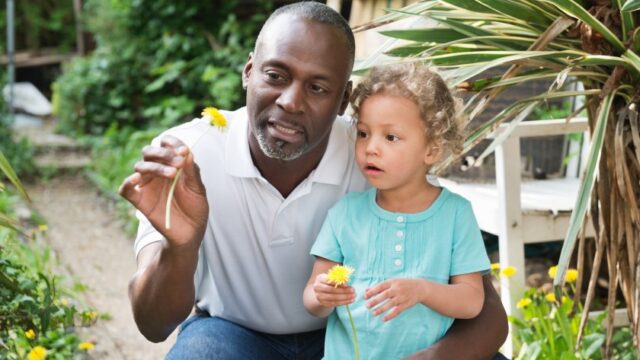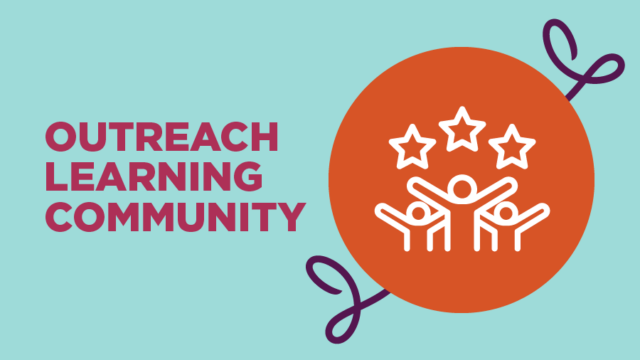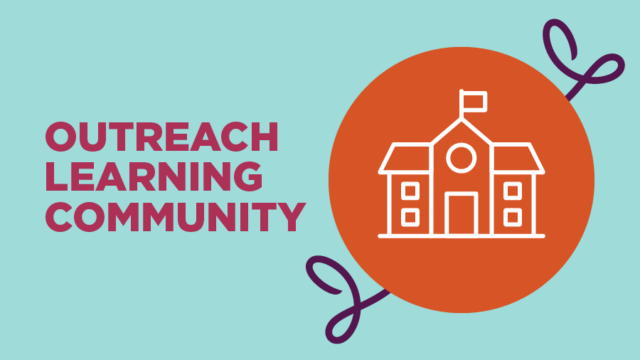Tip Sheet
Identifying and Engaging Untapped Partners to Support Kinship/Grandfamilies
Download This Resource

Introduction
Kinship-serving agencies and organizations partner with various government agencies and nonprofit organizations to provide critical services and support for kinship/ grandfamilies. Yet, there are many other agencies and organizations that you can work with, and these “untapped” sources can help you increase your program’s impact.
This tip sheet provides strategies for building a repertoire of community resources and identifying, engaging, navigating, and maintaining new community connections that will sustain families over time. Use this as a quick reference tool to identify additional community partners that may not immediately come to mind when providing services to kinship families. By developing new partnerships, you can reach a broader group of kinship/grandfamilies and offer them relevant services and support. At the same time, your new partners learn more about kinship families and can expand and adapt their services to better serve this population.
The terms “grandfamily,” “kinship family,” and “kinship/grandfamily” can be used interchangeably to refer to all families in which grandparents, other relatives, or close family friends are raising children whose parents are unable to do so.
Contents
Introduction
Resources Focused on Children/Youth
Human Service Agencies and Organizations
Clubs, Faith-Based Organizations, and Other Local Efforts
Strategies for Identifying and Engaging Untapped Community Resources
Kinship-serving programs can strengthen their services by partnering to:
- Reach more kinship families;
- Expand support to kinship families within their neighborhoods;
- Offer more culturally appropriate service options;
- Co-host special activities;
- Identify in-kind resources;
- Plan cross-site professional development;
- Identify new tools, resources, and subject matter experts; and/or
- Apply for shared funding.
Resources Focused on Children/Youth
Familiarizing yourself with the full range of programs and services that are available to children and youth in your community is paramount. The following are some suggestions for how to engage these important resources.
Schools (public and private) are the most prominent touchpoints for kinship families. Connecting to schools is essential to engaging more kinship families in your services and to supporting schools in helping the families.
- Reach out to the parent-teacher associations at local schools as a way to network and identify families. Attend their meetings to present your services and supports to families. School districts may also have a council of parent-teacher associations, which may be a valuable, consolidated resource.
- Become familiar with student and family support structures and contact persons (counselors, social workers, outreach workers, etc.).
- Present at professional development workshops for teachers.
- Participate in and/or provide materials for distribution at back-to-school nights.
- Request that your information be included in regular newsletters and outreach.
- Encourage school personnel to add kinship support services into the “transitional goals and services” part of Individualized Education Plans (IEPs) for older youth.
Afterschool programs are potent agents for helping kin caregivers, especially those working to provide children with additional educational and cultural/recreational opportunities.
- Contact and provide staff and families at afterschool programs with literature about your services.
- Partner with afterschool programs during special events to highlight the benefits of your services to kinship families.
- Become a member of an afterschool program’s advisory board to build connections with kinship families.
- Give short presentations at orientation sessions for afterschool programs.
- Provide kinship youth identified through afterschool programs with internships or volunteer opportunities at your agency or organization.
Children/youth-serving organizations know their population and can be conduits to engaging kinship families. Working with them is a win-win solution because they provide kinship programs with access to families, while kinship programs expand the services and support these other organizations can offer to children/families. These organizations can also be natural partners for shared funding with kinship programs. The following is a partial list of key organizations developed based on an internet search for top youth agencies. A similar search focused on your community might turn up additional leads. Try multiple searches using different keywords.
- The ASPIRA Association “is the only national Hispanic organization dedicated exclusively to developing Hispanic youth’s educational and leadership capacity.”
- Childhood Education International exists to promote innovative solutions to education challenges and inspire action that creates positive, sustainable futures for children and youth worldwide.
- Boys & Girls Clubs of America provide a safe place and youth development programs during afterschool hours.
- Big Brothers Big Sisters creates and monitors matches between adult volunteers (“Bigs”) and children (“Littles”).
- Boy Scouts of America offers character-building programs and life skills development for boys and girls.
- Child Care Aware® of America works with more than 500 state and local childcare resource and referral agencies to ensure that families in every community can access quality and affordable childcare.
- Girls Scouts dedicates its resources to providing nurturing environments for girls to build their character for a productive life.
- GLSEN seeks to develop school climates that are safe, supportive, and inclusive for LGBTQ students.
- Head Start and Early Head Start are federally funded, locally run programs for low-income families that promote school readiness in children from birth to age five and help connect families to other community services.
- The National Head Start Association (NHSA) offers opportunities to develop healthier, empowered children and families. NHSA is the voice for children, families, and staff in Head Start programs nationwide.
- The YMCA works within communities to promote youth development, healthy living, and social responsibility.
- YWCA USA’s mission is “to eliminate racism, empower women, stand up for social justice, help families, and strengthen communities.”
This is not an exhaustive list, but contact with these organizations may provide additional resources and yield additional partnerships.
Human Service Agencies and Organizations
This section focuses on agencies and organizations that do not concentrate specifically on children and youth. These entities are contact points for kinship families, and they can expand their intake processes to identify the families as “kinship” and train staff appropriately, enabling them to tailor service delivery (including by making referrals). Key contacts include staff at the following agencies and organizations.
Aging and Disability
- Area Agencies on Aging
- Easter Seals
- State Councils on Developmental Disabilities
- Statewide Independent Living Councils (SILC)
Health
- Community mental health centers
- Hospitals
- Neighborhood medical clinics
- Pediatrician offices
Housing
- Public housing authorities
- Tenants’ rights organizations
General
- 2-1-1 provides referrals to helpful agencies and organizations – see 211.org for more information (in addition to the website linked above)
- AmeriCorps
- AmeriCorps Seniors – RSVP and Foster Grandparents Program
Legal
Public Benefits
- Medicaid/CHIP offices
- Social Security offices
- Supplemental Nutrition Assistance Program offices
- Temporary Assistance for Needy Families (often known by a different name) offices
Tribal
- Indian Country Extensions
- Urban Indian organizations
- Cooperative extensions
- Family Resource Centers
- Foodbanks
- Parks and recreation centers
- United Way
Clubs, Faith-Based Organizations, and Other Local Efforts
Many social clubs, sororities, fraternities, and other groups focus on community service as part of their mission. National agencies and organizations may have local affiliates that are active in individual communities. Community-based entities that do not have a national presence can also provide free resources and donations. The following groups may be willing to partner with you to identify, engage, and support grandfamilies.
- Social/service clubs can offer youth scholarships, program underwriting, and volunteers. The following are some examples.
- Fraternities and sororities (undergraduate and graduate chapters)
- A key contact is the National Pan-Hellenic Council (NPHC), a collaborative umbrella council composed of historically African American fraternities and sororities, also referred to as Black Greek Letter Organizations
- Freemasonry or Masonry
- Kiwanis International
- Lions Club International Foundation
- The Benevolent and Protective Order of Elks
- Fraternities and sororities (undergraduate and graduate chapters)
- Faith-based organizations and houses of worship may provide support services, such as designated family support programs and grief counseling, and/or concrete goods, such as food and clothes.
- Criminal justice support networks can assist families impacted by the criminal-legal system and/or crime. Police outreach programs can reach families that are not involved in the criminal-legal system. Examples are listed below.
- Bureau of Indian Affairs Victim Assistance
- Local police community relations units
- Police Athletic Leagues (PALs) (which provide recreational support for children/youth)
- Programs for families of incarcerated individuals (e.g., Prison Fellowship Angel Tree)
- Victims’ assistance programs (which can provide resources and financial support)
- Grassroots neighborhood associations and other local efforts can provide vital support. Some ideas of organizations and individuals that may be good contacts are listed below.
- Block Captains (who are individuals who may have familiarity with families needing assistance and who provide neighborhood-based supports)
- Community development corporations
- Mutual aid societies
- Neighborhood Watch (which may have knowledge of victims of crime)
- Area businesses may be open to partnerships and/or to one-time donations. The local Chamber of Commerce can promote your program to area businesses, restaurants can provide food for support groups or events, retail stores can offer coupons and giveaways, and funeral parlors can refer families to you and provide grief counseling.
Strategies for Identifying and Engaging Untapped Community Resources
- Educate the general community about kinship/grandfamilies. Do not assume that everyone knows the terms “kinship family,” “grandfamily,” “kin caregiver,” etc. Define the words, the prevalence of kinship families locally and nationally, and the potential intersection of your services and theirs. This education may involve community presentations and participation in agency meetings and neighborhood fairs. Provide promotional materials that represent the families. Offer your website information and additional reading materials that can help explain the strengths and challenges of kinship families. Educating community members may spark their interest in supporting and providing services to grandfamilies and alert unserved caregivers to the benefits of being attached to an agency or organization such as yours. This could result in others contacting you for potential partnerships or identifying themselves as kinship champions in the community. Additionally, once caregivers understand how kinship support may help them, they may be more receptive to your services.
- Offer professional development workshops to agency and organization staff. These workshops can include in-person sessions and webinars on kinship families that can be added to yearly training schedules. You can also participate in and present at national conferences to educate professionals in fields that do not necessarily focus on kinship families. Consider cross-site professional development with multiple agencies. Consider concluding your workshops and professional development presentations with a call to action to highlight ways organizations and agencies can get involved in your kinship work.
- Educate your agency or organization about the service population of your potential partners. It is essential to know the demographics of the constituency served by potential partners so that you can suggest culturally appropriate collaboration opportunities, such as family events around important holidays.
- Identify and engage organizations serving immigrant communities. Many kinship families in immigrant communities see their family structure as a part of their culture and do not define themselves as kinship families. Therefore, they may not be aware that they are eligible for kinship services and may need assistance navigating bureaucracies. However, it is important to recognize cultural practices and language barriers that may interfere with service delivery. Subcontracting with agencies and/or organizations dedicated to these populations will help you to reach these families and strengthen your services. A local office of immigrant services can be a key starting point.
- Find entry points and criteria for services. Learn other agency and organization recruitment methods and how kin caregivers connect with and qualify for services. Identify primary contacts at organizations, as well as community stakeholders/leaders. Neighborhood newsletters provide a glimpse into who the community leaders are, what they are doing, and upcoming events. Local service directories focusing on family resources could provide key contacts. This information will help you make referrals, understand where there may be overlapping services, and find opportunities for collaboration.
- Help untapped partners address challenges when they want to provide free or reduced-price services to grandfamilies. Some parks and recreation departments and agencies and organizations that provide afterschool programming offer free memberships or camps to children in foster care, which is an easily defined population. Providers may want to offer the same free or reduced-price services to children in all kinship/ grandfamilies, but, outside of the child welfare system, it is harder to determine if children are being raised by kin or just being dropped off or picked up by their grandparents or other kin. Educate your partners about the fact that many kin raise children without court orders or other legal documents and suggest that providers ask caregivers for one of the following documents instead.
- Records from a school, hospital, health care provider, and/or social service agency (such as a developmental disabilities provider) listing the kin caregiver as the point of contact for the child
- Statements that the kin caregiver receives a public benefit, such as Temporary Assistance for Needy Families, Supplemental Security Income, Medicaid, housing assistance, or Supplemental Nutrition Assistance Program benefits, on behalf of the child
- The kin caregiver’s income tax return listing the child as a dependent
- Private health insurance showing that the child is covered as a dependent under the kin caregiver’s policy
- A private lease showing that the child lives in the kin caregiver’s home (without the child’s parents)
- Other proof that the child lives in the kin caregiver’s home, like school or other non-personal mail to the child at that address (but this would need to be combined with something else to avoid capturing multigenerational households, where mom and/or dad is also in the home raising the child)
- A letter from a social worker, school/childcare staff, religious leader, or other professional stating that the kin caregiver is raising the child
- Acknowledge the “What’s In It For Me (WIIFM)” principle. WIIFM focuses on people and their needs rather than what you want them to do. It also applies to agencies and organizations you wish to engage to benefit from your services; meeting people/agencies with a mutually beneficial scenario with concrete outcomes for all parties is essential. Arrive at the table with what you have and how it can help them. Be prepared to explain how a partnership can help increase positive outcomes for children and families, reduce duplicate services, and prevent child abuse and neglect. Offer ideas for how the partnership could work. For example, one organization may provide case management while another provides concrete goods or financial assistance.
- Use the Grandfamilies & Kinship Support Network’s resource library, which includes a wide array of fact sheets, tip sheets, videos, and more. The Network website also contains a host of webinar recordings, including “Identifying and Engaging Untapped Partners to Support Kinship Families” and “Intersection of Kinship Care and Culture: African & Caribbean Communities in America.” The Generations United website also features three toolkits and accompanying tip sheets that provide a cultural lens for serving African American, Latino, and American Indian/Alaska Native kinship families.
Reaching out to new community partners can help kinship-serving agencies and organizations to better support the families they serve. Using previously untapped community resources, agencies can expand their services, save money through cost-sharing, tap complementary skill sets, incorporate more culturally relevant opportunities, explore new service models, and improve efficiency. Partnering with another agency or organization also strengthens the value proposition of both organizations to their constituents. In the end, collaborating with new community partners expands the range of services for kinship families and empowers them to expand their support system.


